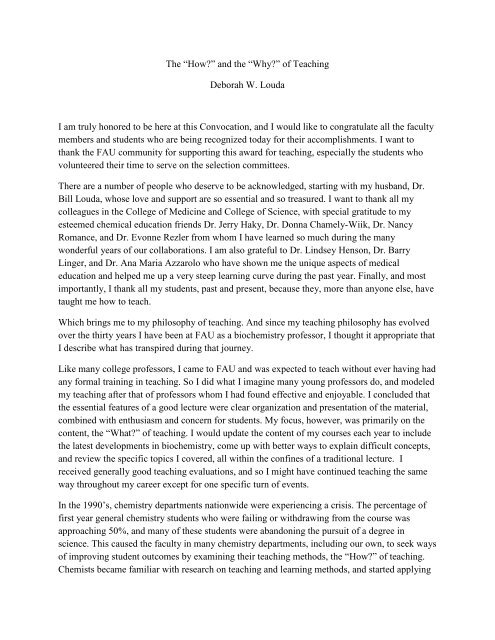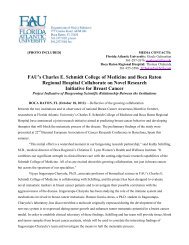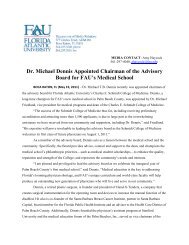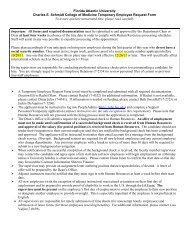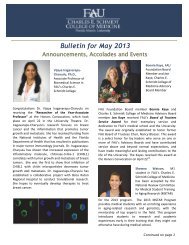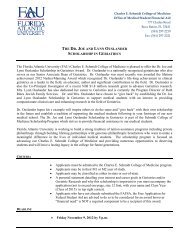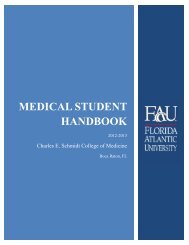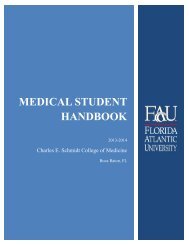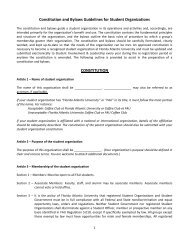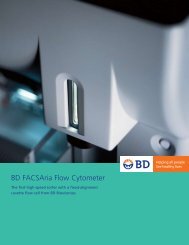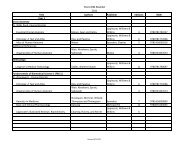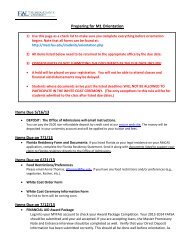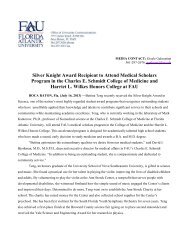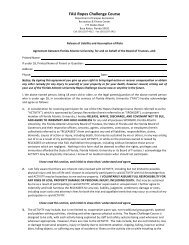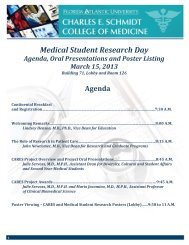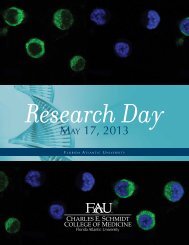of Teaching Deborah W. Louda I am truly honored to be here at this ...
of Teaching Deborah W. Louda I am truly honored to be here at this ...
of Teaching Deborah W. Louda I am truly honored to be here at this ...
You also want an ePaper? Increase the reach of your titles
YUMPU automatically turns print PDFs into web optimized ePapers that Google loves.
The “How” and the “Why” <strong>of</strong> <strong>Teaching</strong><br />
<strong>Deborah</strong> W. <strong>Louda</strong><br />
I <strong>am</strong> <strong>truly</strong> <strong>honored</strong> <strong>to</strong> <strong>be</strong> <strong>here</strong> <strong>at</strong> <strong>this</strong> Convoc<strong>at</strong>ion, and I would like <strong>to</strong> congr<strong>at</strong>ul<strong>at</strong>e all the faculty<br />
mem<strong>be</strong>rs and students who are <strong>be</strong>ing recognized <strong>to</strong>day for their accomplishments. I want <strong>to</strong><br />
thank the FAU community for supporting <strong>this</strong> award for teaching, especially the students who<br />
volunteered their time <strong>to</strong> serve on the selection committees.<br />
T<strong>here</strong> are a num<strong>be</strong>r <strong>of</strong> people who deserve <strong>to</strong> <strong>be</strong> acknowledged, starting with my husband, Dr.<br />
Bill <strong>Louda</strong>, whose love and support are so essential and so treasured. I want <strong>to</strong> thank all my<br />
colleagues in the College <strong>of</strong> Medicine and College <strong>of</strong> Science, with special gr<strong>at</strong>itude <strong>to</strong> my<br />
esteemed chemical educ<strong>at</strong>ion friends Dr. Jerry Haky, Dr. Donna Ch<strong>am</strong>ely-Wiik, Dr. Nancy<br />
Romance, and Dr. Evonne Rezler from whom I have learned so much during the many<br />
wonderful years <strong>of</strong> our collabor<strong>at</strong>ions. I <strong>am</strong> also gr<strong>at</strong>eful <strong>to</strong> Dr. Lindsey Henson, Dr. Barry<br />
Linger, and Dr. Ana Maria Azzarolo who have shown me the unique aspects <strong>of</strong> medical<br />
educ<strong>at</strong>ion and helped me up a very steep learning curve during the past year. Finally, and most<br />
importantly, I thank all my students, past and present, <strong>be</strong>cause they, more than anyone else, have<br />
taught me how <strong>to</strong> teach.<br />
Which brings me <strong>to</strong> my philosophy <strong>of</strong> teaching. And since my teaching philosophy has evolved<br />
over the thirty years I have <strong>be</strong>en <strong>at</strong> FAU as a biochemistry pr<strong>of</strong>essor, I thought it appropri<strong>at</strong>e th<strong>at</strong><br />
I descri<strong>be</strong> wh<strong>at</strong> has transpired during th<strong>at</strong> journey.<br />
Like many college pr<strong>of</strong>essors, I c<strong>am</strong>e <strong>to</strong> FAU and was expected <strong>to</strong> teach without ever having had<br />
any formal training in teaching. So I did wh<strong>at</strong> I imagine many young pr<strong>of</strong>essors do, and modeled<br />
my teaching after th<strong>at</strong> <strong>of</strong> pr<strong>of</strong>essors whom I had found effective and enjoyable. I concluded th<strong>at</strong><br />
the essential fe<strong>at</strong>ures <strong>of</strong> a good lecture were clear organiz<strong>at</strong>ion and present<strong>at</strong>ion <strong>of</strong> the m<strong>at</strong>erial,<br />
combined with enthusiasm and concern for students. My focus, however, was primarily on the<br />
content, the “Wh<strong>at</strong>” <strong>of</strong> teaching. I would upd<strong>at</strong>e the content <strong>of</strong> my courses each year <strong>to</strong> include<br />
the l<strong>at</strong>est developments in biochemistry, come up with <strong>be</strong>tter ways <strong>to</strong> explain difficult concepts,<br />
and review the specific <strong>to</strong>pics I covered, all within the confines <strong>of</strong> a traditional lecture. I<br />
received generally good teaching evalu<strong>at</strong>ions, and so I might have continued teaching the s<strong>am</strong>e<br />
way throughout my career except for one specific turn <strong>of</strong> events.<br />
In the 1990’s, chemistry departments n<strong>at</strong>ionwide were experiencing a crisis. The percentage <strong>of</strong><br />
first year general chemistry students who were failing or withdrawing from the course was<br />
approaching 50%, and many <strong>of</strong> these students were abandoning the pursuit <strong>of</strong> a degree in<br />
science. This caused the faculty in many chemistry departments, including our own, <strong>to</strong> seek ways<br />
<strong>of</strong> improving student outcomes by ex<strong>am</strong>ining their teaching methods, the “How” <strong>of</strong> teaching.<br />
Chemists <strong>be</strong>c<strong>am</strong>e f<strong>am</strong>iliar with research on teaching and learning methods, and started applying
these methods in the chemistry classroom. Here <strong>at</strong> FAU, the result <strong>of</strong> the faculty’s self-educ<strong>at</strong>ion<br />
was Project ChemBOND which encompassed major revisions <strong>of</strong> several basic chemistry courses.<br />
The content <strong>of</strong> lectures was reduced and refined <strong>to</strong> focus on key concepts, and connections<br />
<strong>am</strong>ong concepts were emphasized <strong>to</strong> allow students <strong>to</strong> scaffold their learning in<strong>to</strong> a logical<br />
hierarchy <strong>of</strong> knowledge. Different elements <strong>of</strong> a course, such as lecture and lab, were<br />
coordin<strong>at</strong>ed <strong>to</strong> reinforce important ideas and present them in several different ways. Altern<strong>at</strong>ives<br />
<strong>to</strong> traditional lectures, such as Peer-Led Te<strong>am</strong> Learning and writing exercises, were developed<br />
and integr<strong>at</strong>ed in<strong>to</strong> courses. A common thread <strong>am</strong>ong all these changes was an emphasis on<br />
keeping students motiv<strong>at</strong>ed and engaged in the learning process, <strong>be</strong>cause research in the<br />
cognitive sciences has shown th<strong>at</strong> learning in any discipline is an active process <strong>of</strong> linking new<br />
knowledge with prior knowledge <strong>to</strong> build conceptual understanding. Yet for many students who<br />
experience traditional teaching methods, learning <strong>be</strong>comes a predominantly passive process th<strong>at</strong><br />
is not the <strong>be</strong>st environment for promoting student achievement. Interactive form<strong>at</strong>s, w<strong>here</strong><br />
students particip<strong>at</strong>e in activities such as problem-solving or group discussion, foster learning<br />
more effectively. In fact, student outcomes in chemistry courses, <strong>here</strong> <strong>at</strong> FAU and <strong>at</strong> other<br />
universities, measurably improved when these types <strong>of</strong> revisions were instituted.<br />
Like many teachers, I had some initial resistance <strong>to</strong> making these kinds <strong>of</strong> changes in my<br />
teaching. After all, most <strong>of</strong> my learning in college had occurred in courses with traditional<br />
lectures, and I was comfortable with th<strong>at</strong> form<strong>at</strong>. I was also concerned th<strong>at</strong> these interactive<br />
methods would take time <strong>at</strong> the expense <strong>of</strong> course content. It turns out th<strong>at</strong> I was right about the<br />
time th<strong>at</strong> incorpor<strong>at</strong>ing interactive activities would take. I was also right th<strong>at</strong> the consequence<br />
would <strong>be</strong> the elimin<strong>at</strong>ion <strong>of</strong> some content, but I was wrong <strong>to</strong> <strong>be</strong> concerned th<strong>at</strong> <strong>this</strong> change<br />
would have an overall neg<strong>at</strong>ive effect. The most surprising thing I have learned about teaching is<br />
th<strong>at</strong>, when it comes <strong>to</strong> the classroom, less can <strong>be</strong> more. Filling a lecture with all the facts I think<br />
my students should know is not useful, <strong>be</strong>cause the idea th<strong>at</strong> “if I say it, they will learn” is not<br />
how learning occurs. Instead, I can make my lectures an effective learning experience by keeping<br />
the students engaged while helping them build a solid found<strong>at</strong>ion <strong>of</strong> essential concepts and a<br />
fr<strong>am</strong>ework <strong>of</strong> how these ideas fit <strong>to</strong>gether. Then, with th<strong>at</strong> background, the students themselves<br />
can easily finish the structure by adding the specific, detailed inform<strong>at</strong>ion. And the final measure<br />
th<strong>at</strong> <strong>this</strong> approach works when it comes <strong>to</strong> the “How” <strong>of</strong> teaching is seen in the students’<br />
response, through their questions, interest, performance, and feedback.<br />
The result <strong>of</strong> exploring different teaching methods was my discovery th<strong>at</strong> effective teaching does<br />
not end with picking one <strong>of</strong> the many active learning methods and then incorpor<strong>at</strong>ing it in<strong>to</strong> my<br />
classes. T<strong>here</strong> is a further question <strong>of</strong> deciding which method <strong>to</strong> use and how <strong>to</strong> apply it, and th<strong>at</strong><br />
brings me <strong>to</strong> the “Why” <strong>of</strong> teaching, <strong>be</strong>cause the “Wh<strong>at</strong>” and the “How” ultim<strong>at</strong>ely depend on<br />
the “Why” The reason for my teaching is <strong>to</strong> develop desired characteristics in my students, and<br />
defining those characteristics is the basis for deciding wh<strong>at</strong> and how I teach. One obvious<br />
characteristic is the acquisition <strong>of</strong> content knowledge in the discipline, but t<strong>here</strong> are other<br />
important abilities th<strong>at</strong> instruction should promote, such as critical thinking, problem solving,
cre<strong>at</strong>ivity, self-directed learning, and communic<strong>at</strong>ion skills. If I want my students <strong>to</strong> <strong>be</strong> critical<br />
thinkers, but the only time in my course th<strong>at</strong> they encounter a question th<strong>at</strong> requires critical<br />
thinking is on an ex<strong>am</strong>, I <strong>am</strong> not likely <strong>to</strong> succeed in developing th<strong>at</strong> quality. If I want my<br />
students <strong>to</strong> <strong>be</strong> self-directed learners and then give them a complete, specific list <strong>of</strong> the facts they<br />
are expected <strong>to</strong> learn, t<strong>here</strong> is again a major disconnect <strong>be</strong>tween wh<strong>at</strong> I <strong>am</strong> doing and wh<strong>at</strong> I want<br />
<strong>to</strong> accomplish. Answering the “Why” <strong>of</strong> teaching determines the abilities th<strong>at</strong> are fostered in my<br />
students during their time in my classroom.<br />
The student selection committee for <strong>this</strong> award posed a very insightful question during my<br />
interview. They asked me “Wh<strong>at</strong> are the qualities <strong>of</strong> a distinguished teacher and wh<strong>at</strong> one<br />
question would you ask the nominees for <strong>this</strong> award” I <strong>to</strong>ok a minute <strong>to</strong> think about th<strong>at</strong>,<br />
<strong>be</strong>cause t<strong>here</strong> are many excellent teachers <strong>at</strong> FAU who can effectively explain the content <strong>of</strong><br />
their discipline and who care deeply about their students. The answer I c<strong>am</strong>e up with is th<strong>at</strong> a<br />
distinguished teacher wants <strong>to</strong> <strong>be</strong>come a <strong>be</strong>tter teacher and so continuously ex<strong>am</strong>ines and tries <strong>to</strong><br />
improve the effectiveness <strong>of</strong> his or her teaching, and the question I would ask is “How and why<br />
have you changed your teaching in the past year”<br />
Now if I had more time <strong>to</strong>day, I would <strong>at</strong> <strong>this</strong> point practice wh<strong>at</strong> I have <strong>be</strong>en preaching, and ask<br />
you <strong>to</strong> think about th<strong>at</strong> question, discuss it with your neighbor for a few minutes, and then report<br />
back on the ideas you gener<strong>at</strong>ed. Since we can’t do th<strong>at</strong>, I would encourage everyone who is a<br />
teacher, whether in the role <strong>of</strong> a pr<strong>of</strong>essor, a parent, or a classm<strong>at</strong>e, <strong>to</strong> carefully consider not only<br />
wh<strong>at</strong> your students should know, but wh<strong>at</strong> they should <strong>be</strong> able <strong>to</strong> do, by reflecting on the<br />
“How” and “Why” <strong>of</strong> teaching.


